The Electronic Intifada 3 September 2006
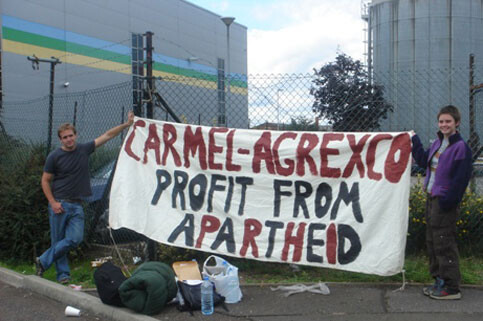
Activists arrived at the UK headquarters of Carmel-Agrexco before sunrise on Wednesday morning for a day of uncompromising protest. The purpose underlying the protest was clear: to expose an Israeli company that is engaging in continuous unlawful and brutal activity by importing fresh produce originating from illegal Israeli settlements in the Occupied Palestinian Territories.
The method of protest chosen by the activists was to construct two large metal triangular cages at each entrance. Protestors secured their necks to the cages by using bicycle D-Locks for over 11 hours with several supporters close at hand. One cage served to totally shut down the exit, and the other caused major disruption at the entrance.
The strategy was ultimately to have arrests take place in order to expose the company’s illegal activity in English courts. However, in a clear display of cowardice a decision was apparently taken by Carmel-Agrexco to withstand the disruption caused by the protestors. Therefore, at the end of the day only one activist was arrested and subsequently de-arrested.
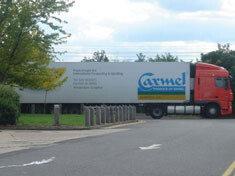

By behaving in such a manner Carmel-Agrexco has incriminated itself and implicitly acknowledged its guilt. The company effectively allowed a “legal blockade” to take place, rather than face a challenge in court.
Those committed to exposing a company that thrives on Palestinian suffering are asked to join in such efforts until the occupier ceases to profit from the occupation.
In the early hours of the morning, Palestine solidarity activists swiftly erected two metal cages in the middle of both entrances of the company despite a “heroic” attempt/assault by one of Carmel-Agrexco’s security guards to fight off the protestors.
The police arrived shortly after the protestors were secured and were in a particularly aggressive mood. In an complete state of paranoia, the police quickly cordoned off both areas outside the gates. By doing so they had inadvertently contributed to the blockade by refusing entry to people and vehicles. When questioned, the police said the area was a “crime scene,” the crime being “aggravated trespass.” For the next 5-6 hours, the police inspected every person, car and truck attempting to pass through the area.
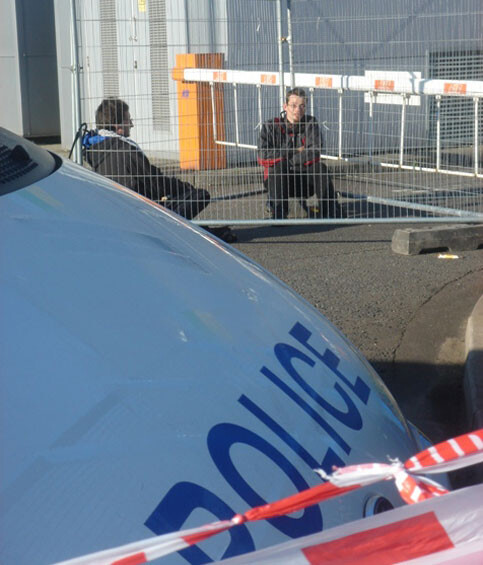
All images Mary Nazzal-Batayneh
In the bitter cold, the four caged-in protestors accustomed themselves to the bicycle locks around their necks and their concrete seats. They would remain locked up and defiant for 11 hours. The headquarters is a monstrous structure featuring a prominently displayed blue and white Carmel logo. In front of the building, a British flag, a Carmel flag, and an Israeli flag are erected side by side.
During the first hour, supporters gave a letter to the police outlining the reasons for the protest. One supporter said, “we are asking the police to investigate the crimes and stop them happening.” At first, the police were reluctant to pay any attention, but took the letter after being told that it would be an important part of the court case. The letter had been previously sent by recorded mail to Carmel-Agrexco.
Over the next two hours, the fire brigade arrived with several pieces of bulky equipment apparently to remove the chained protestors. After some discussion around the cages, the firemen decided they would not cut the protestors out and soon left the so-called “crime scene.”
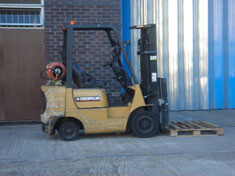
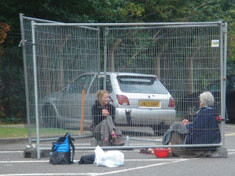
After somehow loosening part of one of the cages, a policewoman squeezed through in order to search the protestors, and then proceeded to remove all their bags and personal belongings. She then informed them that they were arrested. Unfortunately this did not turn out to be the case as a few minutes later another policeman came along and quietly told the pair that they were “de-arrested.”
The other cage was not tampered with, but in a blatant breach of their duty, the police ignored calls to provide the protestors with food, water, and a bucket (mini-toilet). Supporters therefore had to hurl fruit bars, drinks and other items of sustenance to their fellow activists throughout the day.

One supporter was then arrested and driven to the local station for no apparent reason as she was merely a bystander. The police informed her that she was “aiding and abetting an aggravated trespass.” However, the absurdity of such a charge was clear and she was released a few hours later.
At 10:30 am, approximately 5 hours after the protest started, those caged in were given an official warning by the police and by Eric Solomon of Carmel-Agrexco. Activists were told that their activity was unlawful, which prompted a thumbs up signal from one of the protestors. However, they were then told by Solomon that the company would “facilitate their departure” when they were ready to leave. It soon became clear that a decision had been taken to refrain from arresting the group.
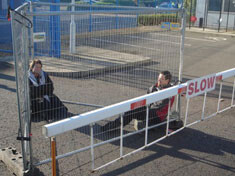

Carmel-Agrexco had declined to have the blockaders charged with aggravated trespass. Instead, they closed the gates thus barricading themselves in their own property. The cordon was taken down and only a few police were left to “secure” the area.
Such a decision prompted pleas from many of the activists. The police were told in no uncertain terms, “please arrest us!” An activist asked one of the constables, “what more do you want?…we are locked up on their property!” Protester Tom Hayes said “Agrexco do not want to prosecute us because when a nearly identical protest was carried out two years ago Agrexco-Carmel’s’ dealings with illegal settlements in the West Bank were forced to be disclosed in court. The experience was very embarrassing and damaging for them.”
Despite being somewhat disappointed at the lack of arrests, the blockade continued for several more hours. Arabic music was played and food was thrown into the cages. Messages of support for the action flooded in from Occupied Palestine, including a special solidarity message from the Stop the Wall campaign which kept everyone’s spirits soaring.

Later on in the day a huge Carmel truck displaying the message “produce of Israel” made its way through one of the gates. It is these lies that will continue to motivate similar future protests.
Having spent over 11 hours on site, the group made a collective decision to leave. Significant disruption had been caused and it seemed as if arrests would not be made. A noticeably nervous and agitated Eric Solomon re-appeared on site to witness the protestors accompanied by police dismantle the cages and depart.
All in all, the action revealed that Carmel-Agrexco does not readily want to prosecute activists for fear that their unlawful activity will be exposed and confirmed. More protests against the company are therefore anticipated and encouraged to stop breaches of human rights and international law in Occupied Palestine.
Mary Nazzal-Batayneh regularly contributes to EI from London.
Related Links


